In reverse glass painting, Dave Archer applies paint to the back side of the glass, which in essence makes the glass his canvas. This is a difficult process that yields effects unparalleled by other painting techniques: vibrant colors, depth of view, even a sense of movement or three dimensions. He mixes media, using a variety of paints and unconventional materials such as metallic powders, crystals, and other substances. Then he hits the mixture with his signature process, using high voltage of electricity to add nebulosity and other fantastic details to his paintings. Amazing technique!
Below are some examples of David Archer's original glass paintings with artist description.
Note: All artwork and images copyright © David Archer. Please do not use images without the permission of the artist.

Bat Out Of Hell (1994). For me, the electric cloud in this piece is moving fast. Like an explosion. Hence the title.
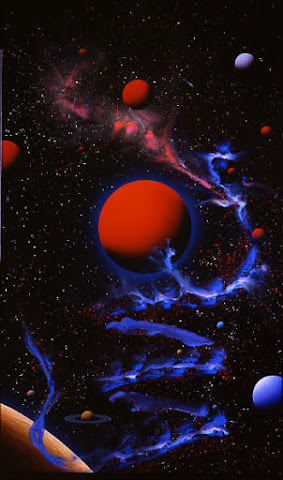
Hexagram (1994). A fire breathing dragon holds a red moon. The title comes from the shape of the dragon's body.

Dream Lover (1988). A Hollywood starlet (who "Michelle" remain nameless) posed in my studio for this painting, on the right with her arms like wings. I made five versions of the piece, all selling rather quickly.
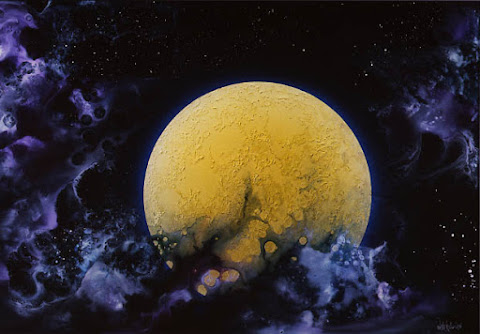
Full Moon (1995). I used to stay in my friends isolated beach house on the island of Molokai, where on full moon nights sometimes black clouds would blow over the moon in the most wonderful way. For painting the craters in this piece I used a moon map for accuracy.

October Tale (1995). This painting lives in a home called, "Painted Spaces," owned by my number one collector, Mr. Larry Kessler, of New York City. I'm a harsh judge of my own work, and I love this painting. Within this "genera" of mine I call, "million volt California high-tech folk art, early 21st Century" ... this is the best I have to offer.
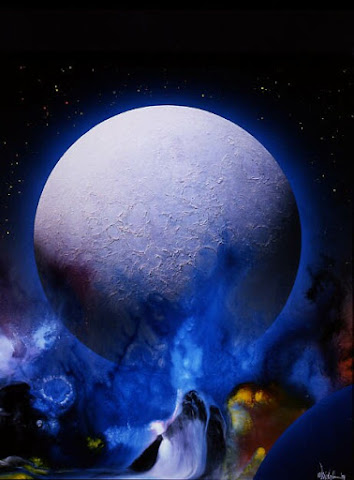
Water Magic (1994). This was a small piece that I always loved and was intending to keep in my private collection. I loaned it as a business sample and it never came back to me. Not only did it never come back, many other "samples" never came back along with it, and sadly, none were ever accounted for. They say if you love something, let it go and if it comes back, it was meant to be. Bullshit. These are the sorts of things that make artists move to Cooper Pedy and take up eating nettles.

Dark Moon (1990). For me, "Dark Moon" has a delicious undertone. I like to go there. Not in a space ship though. In dreams. Looking into my past as far as I can is another form of space travel. In the process I have been forced to accept the obvious, which is, whatever good there is to be said for my kin, I evidently do not come from a long line of dreamers. I therefore, seem to be making up for some recessive art-monster gene in one whole branch of the family tree. Talk about exhausting. Thank you, now go away.

Push / Pull (1997). "Push / Pull" takes its title from modern painter Hans Hoffman's concern with just that. Put simply: how some elements of a picture "push out" while others "pull in," visually as well as viscerally. With this painting, specifically concerning the large blue moon and the smaller red planet beneath it. Red pushes, blue pulls. However, since the blue is bigger in this piece, a stasis is achieved ... bla, bla, bla ... hey, this is a kick ass space painting.

Copper Flame (1997). The clouds in this painting are liberally mixed with copper. Therefore, a metallic sheen highlights even the tips of the blue clouds. On the right side is a "Spectra Foil," moon. "Spectra Foil" is a holographic material that changes color in a subtle, yet exciting way. Lots of small touches make this painting one that has everything.
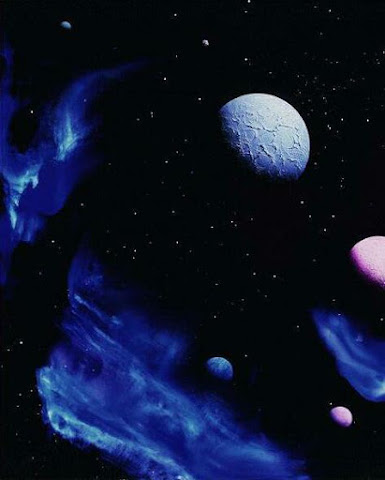
Blue Thunder (1997). The clouds in this piece were painted with one hearty "thunder clap" of 1.5 million volts of electricity, hence the title. A "Spectra Foil" moon is on the right.
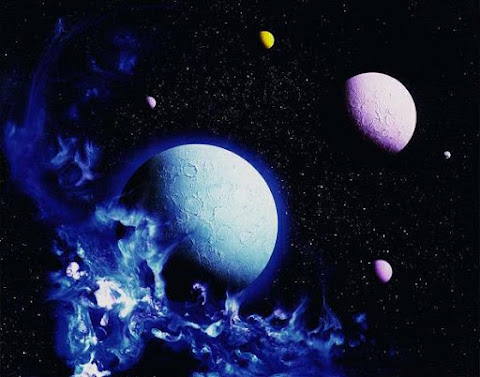
Star Field (1997). An exciting cloud almost like an ocean wave. Title suggests deep space beyond planets and moons, leading to vast regions of mystery.

Black Mountain (1995).

J. P. Aerospace Rises (2002).
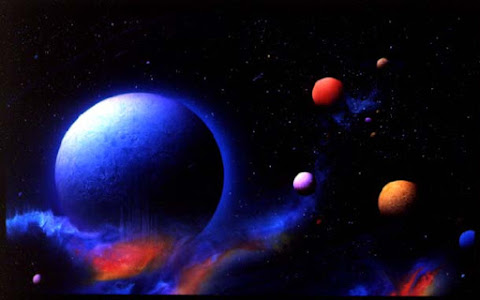
Starry Haven.
Links:
Dave Archer's Gallery
Dave Archer's Electric Machines















0 Comments:
Post a Comment